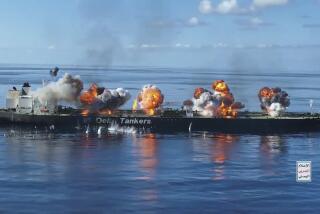Huge Oil Spill in Tokyo Bay Threatens Fishing
- Share via
YOKOHAMA, Japan — In Japan’s worst oil spill, a supertanker gashed its hull near the country’s busiest port Wednesday and dumped nearly 4 million gallons of light crude that drifted toward rich fishing grounds.
By early today, the 11-mile-wide slick had reached land in three places along the industrial shoreline of Yokohama and Kawasaki just south of Tokyo. More than a dozen people were sickened by the fumes.
“The most important thing for us to do now is to limit the extent of the spill,” said Shigehiro Sakamoto, head of the cleanup effort. Tokyo Bay’s fishing grounds help to feed millions in the Japanese capital.
The 147,012-ton, Panamanian-registered Diamond Grace ran aground about 20 miles south of Tokyo, just off the huge port of Yokohama. The leaking stopped about 90 minutes after the accident, and the tanker moved to Kawasaki to be emptied of its shipment.
Kyodo News Service reported that the tanker scraped a reef in shallow waters, tearing holes in oil tanks near the starboard bow. Sakamoto said three tanks were damaged but that only two of them held oil. One of the gashes reportedly was 10 feet long.
Dozens of ships were mobilized to clean up the spill and slow the oil’s advance toward coastal fish stocks. Workers spread absorbent mats on the slick or scooped it up with barrels, buckets and ladles, and helicopters sprayed agents to dissolve the oil.
The spill was nearly twice the size of Japan’s previous worst such accident, which occurred in 1974 when 2 million gallons poured from a storage tank in southwestern Japan. It also was the second major oil accident this year in Japan. In January, a Russian tanker split and sank in the Sea of Japan, spilling 1.2 million gallons of fuel oil and fouling hundreds of miles of shoreline.
The light crude from Wednesday’s spill probably will be easier to clean up than the thicker crude that fouled Alaska’s pristine coast when the tanker Exxon Valdez spilled 11 million gallons in 1989.
“There’s going to be more of it that will evaporate . . . but still, when you’ve got that quantity of even light crude there’s going to be significant beach impact,” said Steve Provant, a U.S. expert who helped oversee the Alaska cleanup.
Early concerns Wednesday were over the oil catching fire. Coast guard boats warned fishing boats against using cigarette lighters or matches. The threat of fire abated by nightfall as the fumes became less potent.
Fifteen people who lived near the bay, including 13 children, were sickened by the strong odor Wednesday and hospitalized.
The Diamond Grace and its 25 crew members had been en route to Kawasaki from the United Arab Emirates, carrying 75.5 million gallons of light crude oil.
More to Read
Sign up for Essential California
The most important California stories and recommendations in your inbox every morning.
You may occasionally receive promotional content from the Los Angeles Times.










